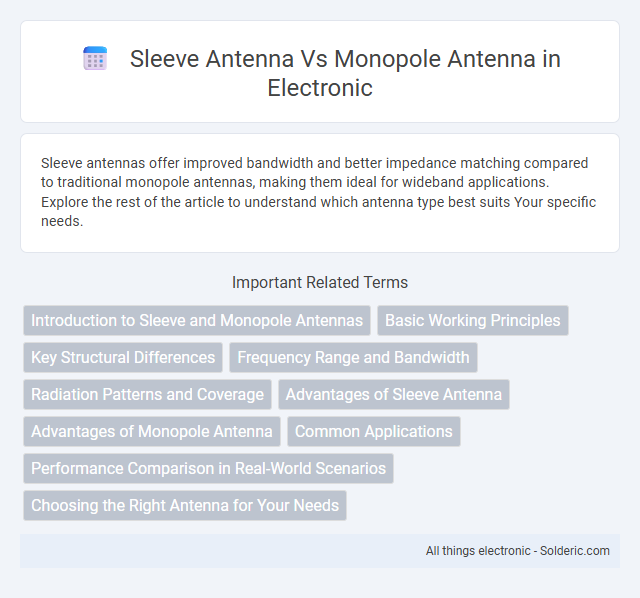Sleeve antennas offer improved bandwidth and better impedance matching compared to traditional monopole antennas, making them ideal for wideband applications. Explore the rest of the article to understand which antenna type best suits Your specific needs.
Comparison Table
| Feature | Sleeve Antenna | Monopole Antenna |
|---|---|---|
| Structure | Coaxial cable with a metallic sleeve around the conductor | Single metal rod or wire mounted perpendicular to ground |
| Radiation Pattern | Omnidirectional, similar to monopole but with improved impedance matching | Omnidirectional in the horizontal plane |
| Impedance | Typically 50 or 75 ohms due to sleeve matching | Approximately 36-40 ohms without matching network |
| Bandwidth | Moderate, improved over simple monopole | Narrower bandwidth compared to sleeve antenna |
| Size | Compact due to integrated sleeve | Simple and often smaller in length than full dipole counterpart |
| Applications | Wireless communications, FM, and VHF/UHF antennas | Mobile communications, base stations, and portable devices |
| Advantages | Better impedance matching and reduced cable radiation | Simple design, easy to fabricate, effective ground plane required |
| Disadvantages | More complex construction than monopole | Requires good ground plane, impedance mismatch without tuner |
Introduction to Sleeve and Monopole Antennas
Sleeve antennas consist of a coaxial sleeve radiator surrounding the feed line, offering a compact design with improved impedance matching and bandwidth compared to traditional monopole antennas. Monopole antennas are single-element radiators typically a quarter wavelength long, relying on a ground plane to reflect signals and create an omni-directional radiation pattern. Sleeve antennas provide enhanced performance in limited space environments, making them suitable for applications requiring efficient broadband operation and stable impedance characteristics.
Basic Working Principles
Sleeve antennas operate by combining a quarter-wavelength monopole with a conductive sleeve that acts as a ground plane, creating a balanced structure that enhances impedance matching and radiation efficiency. Monopole antennas consist of a single conductive element typically mounted over a conductive surface, radiating electromagnetic waves by inducing currents along the element's length, effectively functioning as a half of a dipole antenna. The sleeve antenna's balanced design reduces feed-line radiation, while the monopole relies on the ground plane for image currents, influencing its radiation pattern and impedance characteristics.
Key Structural Differences
Sleeve antennas feature a cylindrical conductor surrounding the radiating element, creating a balanced structure that improves impedance matching and bandwidth. Monopole antennas consist of a single conductive rod mounted perpendicularly on a ground plane, functioning as an unbalanced antenna with simpler construction. The sleeve design enhances performance in compact applications, while the monopole antenna offers straightforward implementation and ease of deployment.
Frequency Range and Bandwidth
Sleeve antennas typically operate effectively within VHF to UHF frequency ranges, offering relatively narrow bandwidth suitable for applications requiring stable resonant frequencies. Monopole antennas exhibit broader bandwidth capabilities across a wide spectrum, from low HF bands to UHF, enabling greater frequency versatility and improved multi-band performance. The choice between sleeve and monopole antennas depends on the specific frequency coverage and bandwidth requirements of communication systems.
Radiation Patterns and Coverage
Sleeve antennas exhibit a more omnidirectional radiation pattern with improved vertical coverage, making them ideal for applications requiring consistent signal strength in all horizontal directions. Monopole antennas typically have a narrower vertical radiation angle, resulting in focused coverage primarily along the horizon but limited upward or downward signal reach. Your choice between these antennas should consider the desired coverage area and environment, as sleeve antennas provide broader spatial coverage compared to the directional emphasis of monopoles.
Advantages of Sleeve Antenna
Sleeve antennas offer superior impedance matching and wider bandwidth compared to monopole antennas, making them ideal for applications requiring efficient signal transmission. Their balanced structure minimizes noise and signal distortion, enhancing overall performance in dense electromagnetic environments. You benefit from improved durability and compact design, which supports integration into portable and wearable devices.
Advantages of Monopole Antenna
Monopole antennas offer compact design and simplified construction, making them highly efficient for limited space applications and portable devices. Their omnidirectional radiation pattern ensures consistent signal reception and transmission across broad coverage areas. You benefit from easier installation and better ground plane compatibility, boosting overall antenna performance in various environments.
Common Applications
Sleeve antennas are commonly used in applications requiring compact size and omnidirectional patterns, such as GPS devices and aircraft communication systems, due to their efficient radiation characteristics and ease of integration. Monopole antennas are frequently employed in mobile and base station communications, including cellular networks and radio broadcasting, because of their simple design and effective vertical polarization. Your choice between these antennas depends on the specific application needs, such as space constraints and signal propagation requirements.
Performance Comparison in Real-World Scenarios
Sleeve antennas exhibit superior performance in urban environments due to their enhanced impedance matching and reduced signal reflections compared to monopole antennas, resulting in more stable and efficient signal transmission. Monopole antennas tend to perform better in open rural areas where their omnidirectional radiation pattern allows for broader coverage despite higher susceptibility to interference. Real-world testing shows sleeve antennas achieve higher gain and lower VSWR, improving overall communication reliability in complex signal environments like dense buildings or vehicle-mounted systems.
Choosing the Right Antenna for Your Needs
Sleeve antennas offer compact design and improved impedance matching, making them ideal for applications requiring limited space and reliable signal strength. Monopole antennas provide broader bandwidth and higher gain, suitable for outdoor or long-range communication scenarios. Your choice depends on the specific requirements of size, frequency range, and transmission distance, ensuring optimal performance for your wireless system.
sleeve antenna vs monopole antenna Infographic

 solderic.com
solderic.com